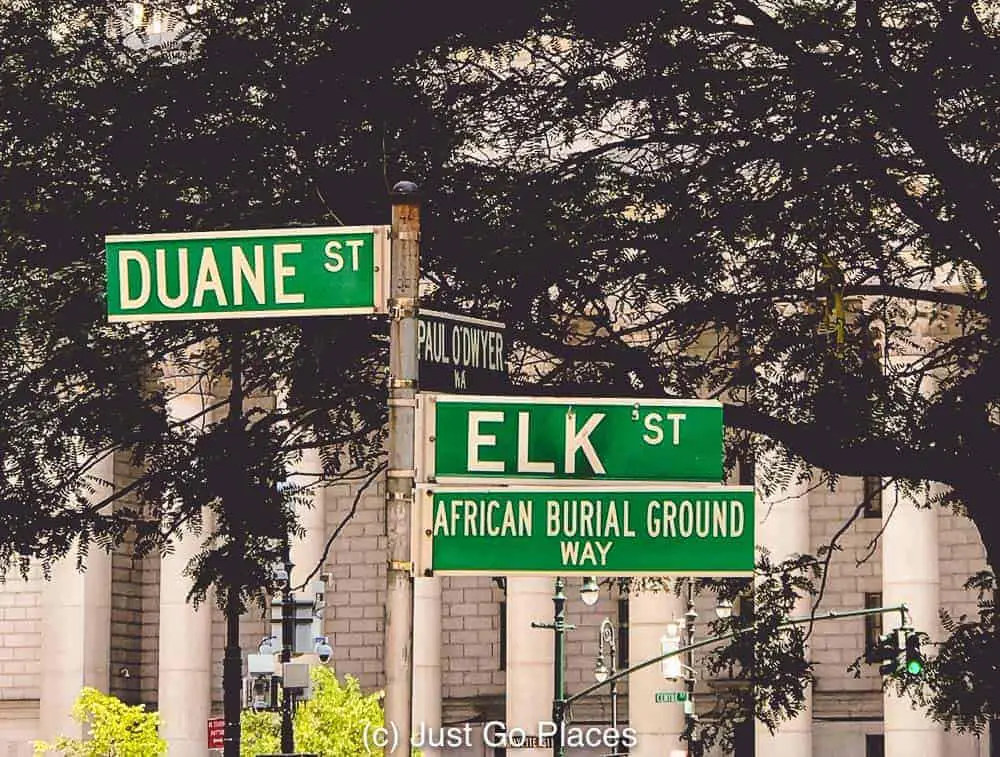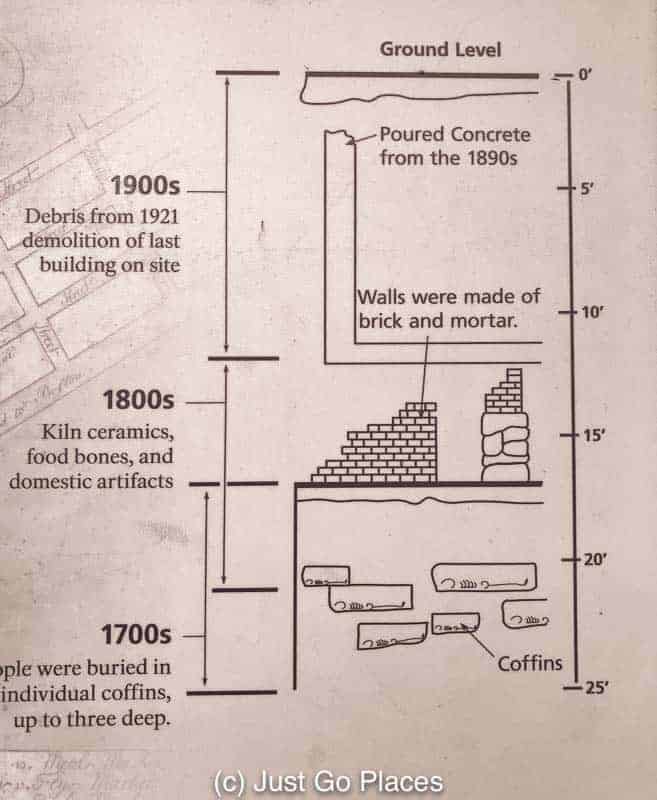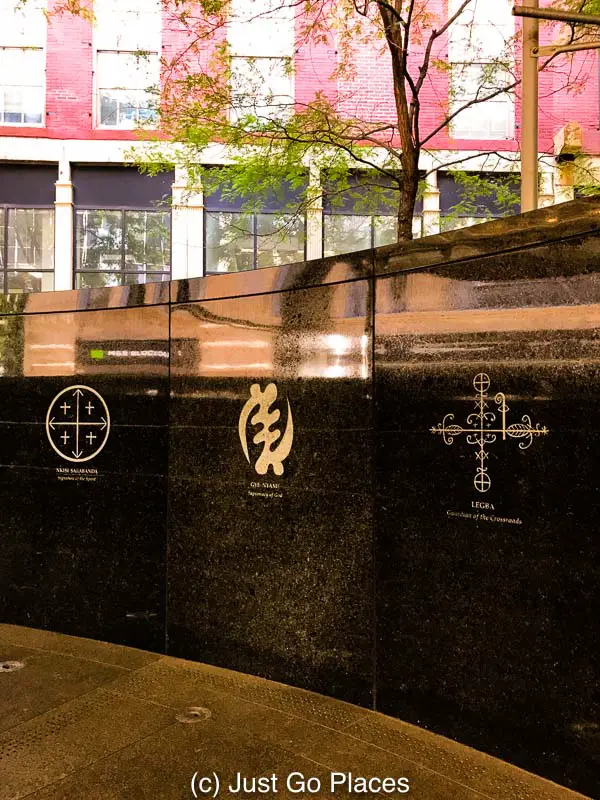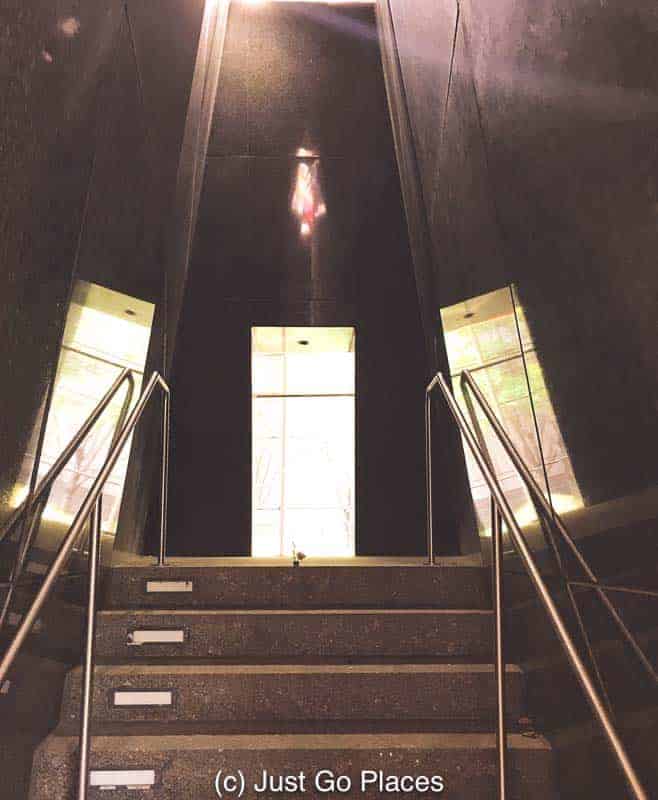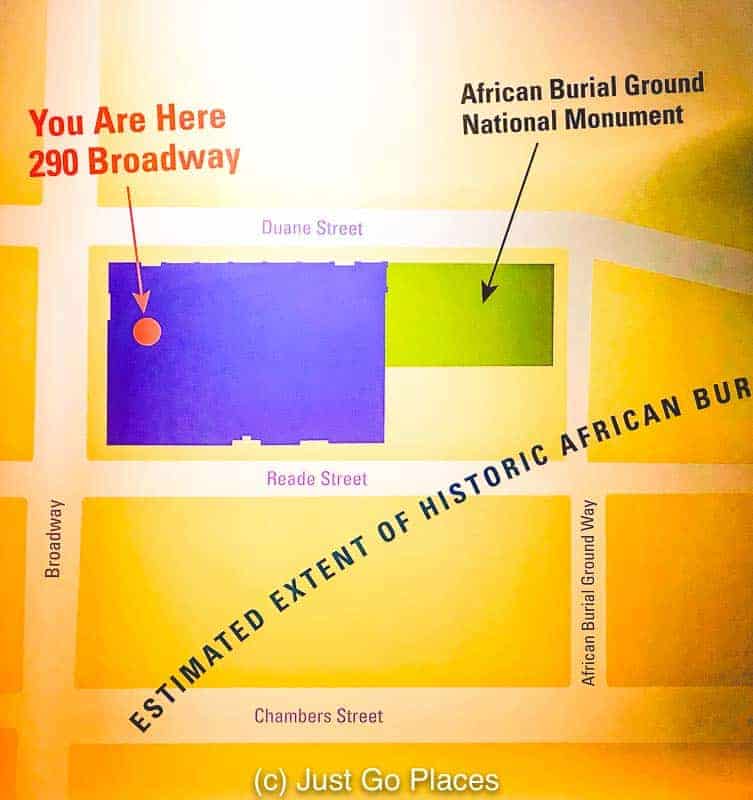The African Burial Ground in New York City is a national monument operated by the National Park Service in Lower Manhattan. One of the most important black historical sites in New York, the African Burial Ground Museum is also one of the coolest little museums in downtown NYC. The exhibits at the African Burial Ground Monument show not only the African burial ground history itself but also how the Dutch imperialism of the Dutch West India Company contributed to slavery in New Amsterdam. Ultimately when New Amsterdam becomes New York, slavery in New York colony became crucial to the economy in colonial New York.
Contents
African Burial Ground History
The African Burial Ground was an accidental discovery in 1991 when the federal government started excavating at 290 Broadway for a new Federal office builidng. When human remains were found many feet below the surface, the long-forgotten African Burial Ground history came to light.
This African Burial Ground in New York City was a burial site for both free and enslaved slaves because slaves were not permitted to be buried in churchyards. .This plot of land in a ravine became a de facto burial ground. It was owned by a Dutchwoman who herself owned slaves.
Her family sold the land in 1795 to developers to build houses. The ravine got filled with as much as 25 feet of landfill to level it off and make it suitable for housing. As a bonus, the bodies underneath the landfill were preserved. A new cemetery for blacks was opened further uptown in Manhattan.
The existence of this unofficial African burial ground in New York was lost in the mists of time until the 20th century. It is an important archeological discovery and sheds light on the importance of both free and enslaved Africans in the early development and prosperity of New York City.
Dutch Imperialism in New York
The first known person of African descent in New York was Juan Rodrigues. Rodrigues was a Portuguese/African sailor from Santo Domingo who set up a trading post in New Amsterdam in 1613 for the valuable trade of beaver pelts. (New Amsterdam later became New York after the Dutch lost their colony to the British in 1664).
In fact, Juan Rodrigues set up his trading post before the early Dutch settlers in New York arrived.
The first known African slaves arrived as labor for the Dutch West India Company in 1625 shortly after a boatload of 30 Dutch families sponsored by the Dutch West India Company arrived to colonise the land in 1624.
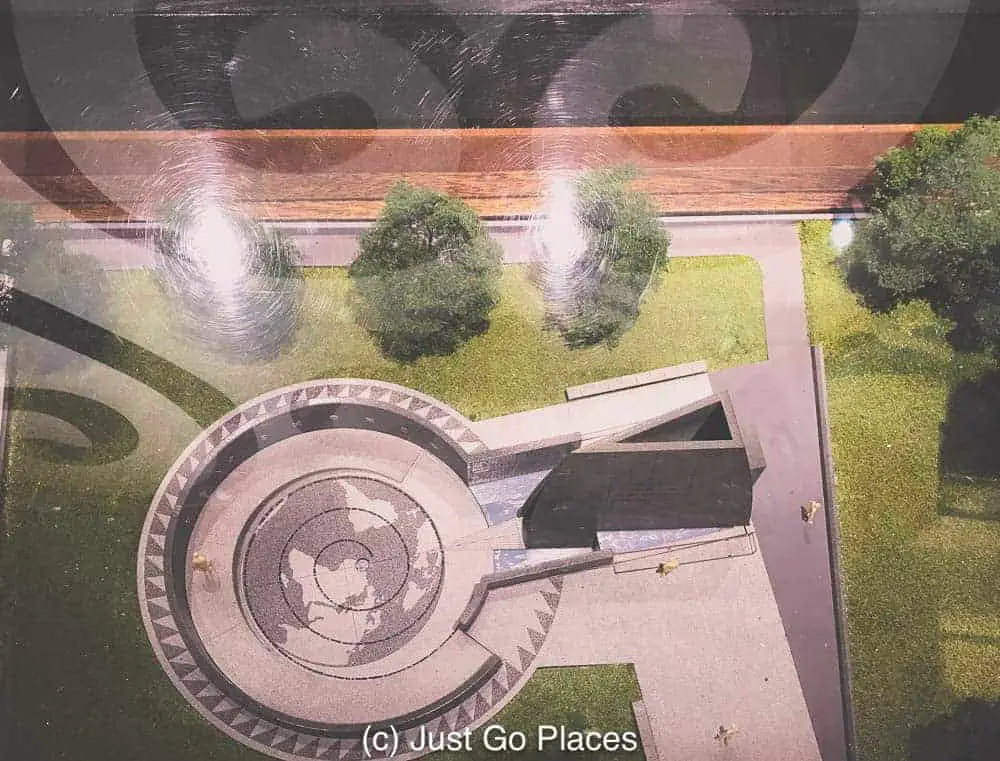
A diorama of the outdoor part of the African Burial Ground National Monument under the shadow of the sankofa symbol.
Early Dutch settlers in New York needed enslaved Africans for the growth of their colony because there was a severe shortage of labor.
For example enslaved Africans cleared a local Native American trail to create Broadway to allow passage of horse drawn wagons in 1658. This road connected New Amsterdam with Manhattan’s second Dutch village, New Haarlem.
The African enslaved also built the wall at Wall St in 1653 under the orders of Governor Peter Stuyvesant to protect the colony of New Amsterdam. The wall stretched from the Hudson to East River. Under the British, this wall was also torn down by the African enslaved in 1699 to accommodate the growing colony.
In 1711 there was a market on Wall Street to hire out enslaved men as day labourers. For example, in the early 1800’s enslaved labor worked for a $1 a day to build the city’s pipe system. The money went to the enslaved men’s owners.
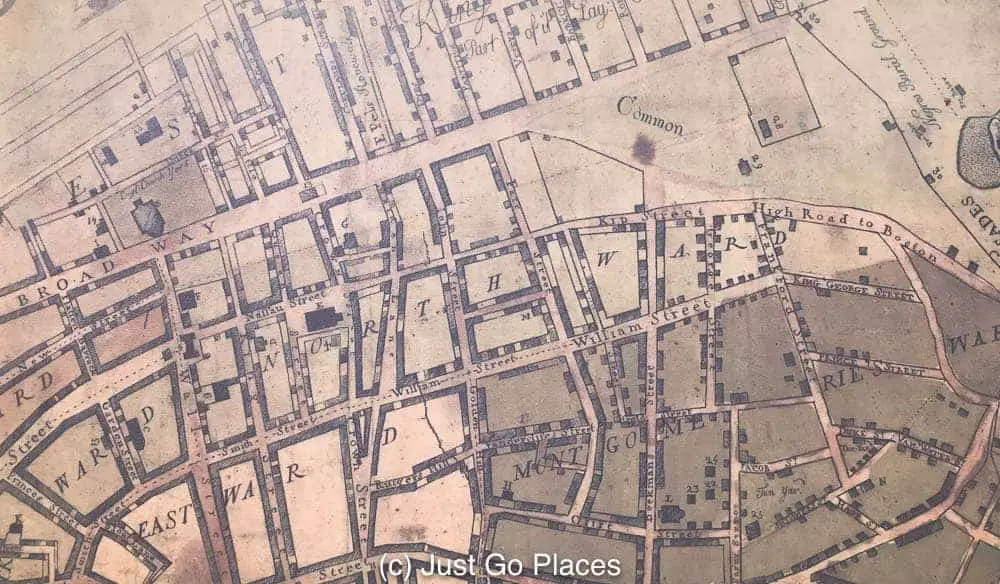
You can see the location of Broadway and Wall Street to the lower left of this map and the New York African Burial Ground on the upper right hand corner
Slavery in New Amsterdam
The West India Company and Stuyvesant worked to promote the production of sugar cane which was a slave-intensive process. New York City became a major center for the North American slave trade.
For example, from 1711-1762 the city’s official slave market was located on a pier at Wall Street and the East River. The official slave market known as the Meal Market had several unofficial competitors as well. Slaves were sold or rented on a daily or weekly basis at these markets.
By the time New Amsterdam becomes New York, 15% of the population n NYC 1664 were Africans.
Slavery in New Amsterdam was regulated by the Dutch West India Company. They could own property, be baptised and marry.
Under the Dutch, enslaved Africans even had hope of getting freedom eventually. For example, slaves often oversaw the work of Dutch absentee farmers which gave them a certain amount of freedom.
The Dutch settlers of New York in 1644 even gave conditional freedom to 11 slaves and gave them 100 acres of farmland in the part of Manhattan now between Canal Street and 34th street. These freed Africans still had to pay the West India Company in crops and livestock. Moreover, although the former slaves and their wives were freed, their children were kept as slaves. The freed slave parents were able to buy back their kids eventually.
And, bonus! The farms of the former enslaved provided a buffer against any Native American attacks on New Amsterdam itself.
Slavery in New York Colony
In NYC 1664 was the year that these limited rights were stripped away when England took over the colony and New Amsterdam becomes New York.
Slavery in NYC (1664 Through the American Revolution)
The English rescinded the tight of free blacks to own land in Manhattan. Africans made up about 20% of the colonial population by the mid 18th century.
There was a supposed slave insurrection in 1741. Historians aren’t entirely sure what happened. The story is that poor whites and slaves joined forces to revolt and to kill all the white men. There were rewards offered for testimony which lead to mass hysteria. So many enslaved men were jailed there was no room in the jails to hold more. Eventually, 31 blacks and four whites were executed (conveniently near the African Burial Ground so you know where the blacks bodies went).
During the American Revolution, the British occupied New York as George Washington and his forces fled south. The British were in charge of Manhattan from 1775-1783 and recruited African (and African Americans) to their side by promising them freedom. When the British left in 1783, they took their African soldiers with them.
The Economy in Colonial New York
So slavery was integral to the economy in colonial New York. The enslaved not only worked in the farms, but also built the infrastructure of the city as the first municipal work force. Skilled enslaved labor worked as everything from butchers, bakers and candle stick makers (as the old nursery rhyme goes).
And, it wasn’t just the men. Enslaved women worked in their owners’ homes doing domestic chores and taking care of their owner’s children.
Enslaved children were made to work from the age of 5 or 6. Many enslaved children died in early childhood. Nearly half the people buried at the African Burial Ground New York City were under the age of 16, with the majority of those under the age of 2.
Unlike in the Southern states, slave owners in New York were not interested in breeding Africans. Infants, therefore, were a just a burden on their mothers times. Enslaved mothers were expected to carry out all their duties irrespective of whether they had just had a baby. When you consider how overworked and nutritionally deprived the mothers were, it is not surprising that so many babies died!
Slavery in Post-Colonial New York
The first New York Constitution created in 1777 ignores the issue of slavery and thereby allows it to continue.
In 1785 the New York Manumission Society organises with the aim of having slavery abolished in New York,
Eventually, New York passes a gradual emancipation act stating that children born after July 4, 1799 to enslaved women were no longer born into slavery. Slavery was abolished in New York in 1827 in its totality. After slavery was abolished, Africans in New York still faced discrimination and injustice.
African Burial Ground Facts
The African Burial Ground eventually got so crowded the coffins were piled 4 deep in the site!
It covered approximately 6 acres and held the remains of an estimated of 15-20,000 people dating from 1630s to 1795.
Despite the huge number of people buried at the African Burial Ground, these burials were not a mass grave. Most of the deceased had coffins and some were in clusters indicating families buried together.
Only about 10 percent of the burials happened without coffins and it’s surmised these burials happened during and after the American Revolution.
There were strict rules on what was allowed at African burials. For example, no more than 12 mourners were permitted at a procession or at the graveside. A 1722 rule bans burials at night.
Over 40% of the people buried at the African Burial Ground were children under the age of two.
Research on the human remains found at the New York African Burial Ground showed how short and brutal the lives of the enslaved were. The bodies showed the effects of a limited diet and back breaking manual labor.
African Burial Ground National Monument
There is an outdoor memorial at the African Burial Ground Monument which is in three parts – The Circle of the Diaspora, the Ancestral Libation Chamber, and the Ancestral Reinterment Ground.
The Circle of the Diaspora
The Circle of the Diaspora is an homage to the many areas and cultures in Africa from where the enslaved originated before they were dispersed to captivity in the New World. The slave trade occurred in many parts of Africa including what is now Sierra Leone, Ghana, Nigeria, Mozambique and Madagascar. In fact, slave owners preferred women and children straight from Africa because they were thought to be more easily controlled.
African Burial Ground symbols are engraved on the on the perimeter wall of the circle such as the sankofa (a heart shaped symbol which appears throughout the African Burial Ground Monument.
African Burial Ground symbols carved on the perimeter wall from the areas in Africa where the enslaved originated.
Ancestral Libation Chamber
The Ancestral Libation Chamber is made from green African granite and shaped like a ship’s hold reminiscent of the slave ships that brought the enslaved to the New World. The most popular of the African Burial Ground symbols, the sankofa, is engraved the outside. The chamber is 24 feet high and represents the soaring African spirit of the deceased.
The Ancestral Reinterment Ground
There were 419 bodies removed from the African Burial Ground NYC before the excavation of the site was stopped in 1992 by mass protests at the disturbance of sacred ground. .
In 2003, the human remains found at the NY African Burial Ground were reburied in hand-carved Mahogany coffins made in Ghana and lined in Kente cloth. In the intervening years, the archoeological trove was studied by researchers at Howard University in Washington D.C..
The coffins were placed in 7 crypts under 7 burial mounds and guarded by 7 trees.
African Burial Ground Museum
The African Burial Ground Museum is small but informative (perfect for an introduction to this period in history for children!).
For example, there is a copy of the certificate granting conditional freedom in 1644 by the Dutch West India Company to Pieter San Tome, one of the earliest slaves brought to New Amsterdam. Pieter San Tome was one of the 11 formerly enslaved who were given buffer farms for themselves north of New Amsterdam.

Here you can see the lands given to the 11 freed slaves in relation to the African Burial Ground Manhattan which was itself a far outpost of New Amsterdam
The short, clear exhibits outlines the progression of slavery in New Amsterdam and slavery in the New York Colony. It also discusses the African American experience after slavery abolished in New York, including its place in the Underground Railroad which helped the enslaved in the Southern USA flee for freedom.
The Visitor center has a terrific bookstore on the experience of slavery in the United States as well as the ongoing struggle for Civil Rights for all Americans.
Visiting The African Burial Ground National Monument
There are free tours of the African Burial Ground Monument but it’s just as easy to visit independently. Admission is free to the NYC African Burial Ground.
There are two parts to the African Burial Ground National Monument – the outdoor memorial to African Burial Ground Manhattan and an indoor African Burial Ground Museum.
The African Burial Ground museum and visitor center is around the corner from the New York African Burial Ground. The visitor center is open Tuesday through Saturday from 10-4. The African Burial Ground museum is closed for Thanksgiving Day and Christmas Day.
Interested in learning more About the African-American experience in New York City? Check out these tour options!
- 4 Hour Harlem Gospel Tour
- 2 hour Harlem: Sunday Gospel Service
- 4 Hours Birthplace of Hip Hop Harlem and the Bronx Tour
- Half Day charm of Gospel and Harlem Tour
- 2 Hour Slavery and Underground Railroad Tour
- 5 hour Harlem Soul Food & Jazz Walking Tour
- 2 Hour Harlem Walking Tour and Swing Dance Class
- 4 hour Mount Morris Harlem Gospel Tour and Brunch
SPREAD THE WORD! PIN THIS TO YOUR TRAVEL PINTEREST BOARDS FOR FUTURE REFERENCE!
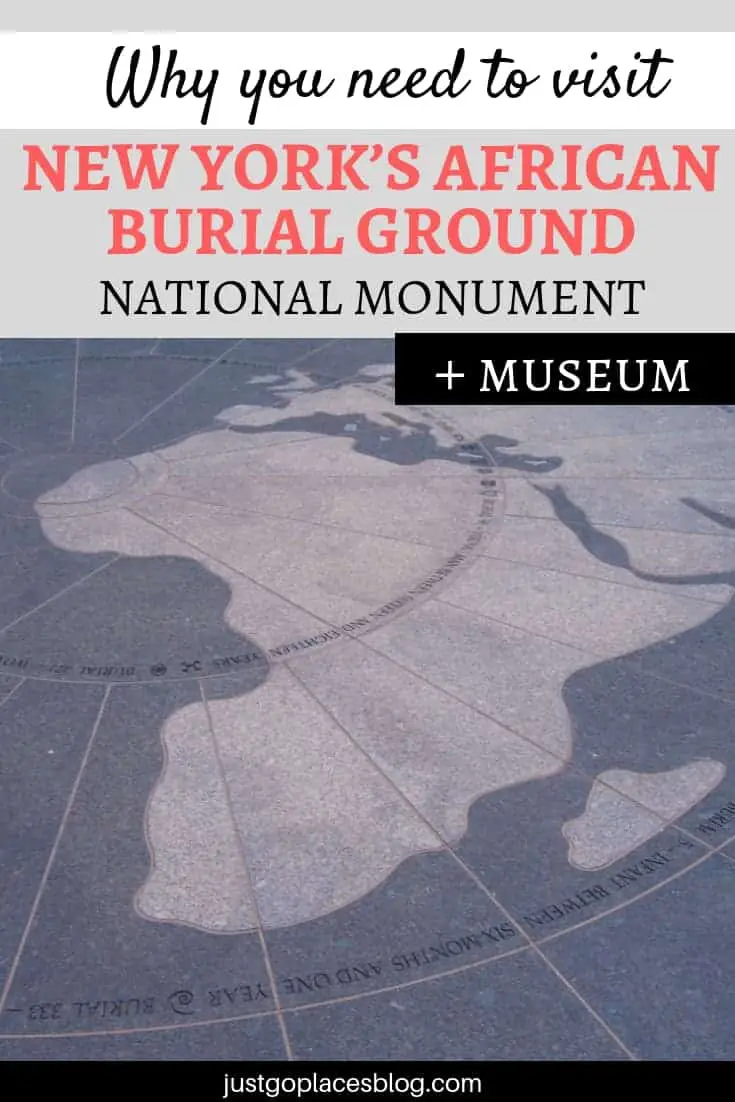
Why You Need To Visit The African Burial Ground New York City (+ Learn About Slavery’s Importance to the Economy of Colonial New York)

The African Burial Ground National Monument is one of the most important black
history sites in New York City, and one you should really visit (also with the kids) to
learn the history behind this place. Discovered only in 1991, it was a burial site for
both free and enslaved slaves, and visiting will move you. Check out why you need to visit the African Burial Ground, NYC.
This site generates income via partnerships with carefully-curated travel and lifestyle brands and/or purchases made through links to them at no extra cost to you. More information may be found on our Disclosure Policy.

